- electronic control unit;
- sensors:
- 1. crankshaft position sensor;
- 2. camshaft position sensor;
- 3. throttle position sensor;
- 4. knock sensor;
- 5. coolant temperature sensor;
- 6. mass air flow sensor;
- 7. vehicle speed sensor;
- 8. oxygen concentration sensor;
- executive devices:
- 1. main relay;
- 2. fuel pump relay;
- 3. nozzles;
- 4. ignition coil or ignition module [The ignition module was installed on cars of the first years of production.];
- 5. idle speed regulator;
- 6. relay of the electric fan of the cooling system;
- 7. a control lamp of malfunction of a control system of the engine;
- 8. adsorber purge valve;
- connecting wires;
- diagnostic socket.
The engine management system is also integrated:
- car anti-theft system;
- speedometer;
- tachometer.

Location of elements of the engine management system 2111 (1,5i) in the engine compartment: 1 - installation location of the crankshaft position sensor (in block tide); 2 - nozzles; 3 - throttle position sensor and idle speed controller (mounted on throttle body); 4 - camshaft position sensor; 5 - mass air flow sensor; 6 - adsorber purge valve; 7 - coolant temperature sensor; 8 - module (coil) ignition; 9 - spark plugs with tips of high-voltage wires put on them; 10 - knock sensor
The main control element of the system is electronic control unit (ECU), or, as it is often called, a controller with an integrated microprocessor. In fact, an ECU is a specialized mini-computer in which only one program is installed - engine control, and sensors and actuators form the peripheral equipment of this computer. The unit receives and analyzes the sensor signals. Based on the received data, the block calculates control commands and issues them to the actuators. There are three types of memory in the unit [The design of the computer may be changed by the manufacturer.]: ROM (ROM), random access memory (RAM) and flash memory (PROM). ROM - non-volatile memory (that is, the information in the memory is retained when the power is turned off) and is a microchip ("chip") [The design of the ECU is subject to change by the manufacturer.]. The microcircuit is installed on the block board through a plug-in connection - a special block, and is not soldered like other elements. This was done in order to unify the ECU for various car models. The ROM stores the calculation program and the data necessary for the calculation (engine parameters, transmission ratios and other characteristics). This information is individual for each vehicle modification.

Electronic control unit (ECU)
Warning! Unqualified ROM reprogramming or chip replacement from another car model (so-called chip tuning) can lead to malfunctions of the engine, failure of the elements of the engine control system, engine damage.
The RAM stores fault codes detected by the ECU self-diagnosis system and operational information that the ECU microprocessor uses in calculations.
The EEPROM stores codes for the car's anti-theft system (immobilizer). This type of memory is non-volatile. After activating the immobilizer, the ECU blocks the operation of the engine management system when trying to start the engine without special electronic keys.
The immobilizer control unit, fuses and relays of the engine management system are located under the instrument panel console.
crankshaft position sensor (DPKV) is designed to generate signals by which the ECU synchronizes its work with the cycles of the engine's working process. Therefore, often this sensor is called a synchronization sensor. The operation of the sensor is based on the principle of induction - when the teeth of the crankshaft pulley pass by the sensor core, alternating current voltage pulses occur in the sensor circuit. The frequency of appearance of pulses corresponds to the frequency of rotation of the crankshaft. The teeth are located around the circumference of the pulley (after 6°). Two of them are separated from each other at an angular distance of 18°. This was done to form reference signals in the sensor circuit - peculiar reporting points, relative to which the ECU determines the position of the crankshaft - top dead centers in the first / fourth and second / third cylinders. Engine operation with a faulty crankshaft position sensor is not possible. The crankshaft position sensor cannot be repaired - in the event of a malfunction, it is replaced as an assembly.

crankshaft position sensor
Camshaft position sensor (DPRV) designed to generate a signal by which the ECU determines the top dead center (TDC) piston of the first cylinder during the compression stroke. Sometimes this sensor is called a phase sensor. The camshaft position sensor is installed in the cylinder head cover. The principle of operation of the sensor is based on the Hall effect. When the protrusion of the ring attached to the intake camshaft pulley passes through the slot in the end of the sensor, the sensor sends an electrical signal to the computer. In the event of a malfunction of the DPRV, the electronic control unit switches the system to a standby mode of operation.
The camshaft position sensor is an electronic device that cannot be repaired. If the sensor is defective, it must be replaced.
Knock sensor (DD) - piezoelectric, reacts to engine vibration. The knock sensor is mounted on the front wall of the cylinder block. Based on the signals from the sensor, the ECU determines the moment of detonation when the engine is running and, in accordance with this, corrects the ignition timing. In the event of a malfunction of the DD, the electronic control unit switches the system to a backup mode of operation.
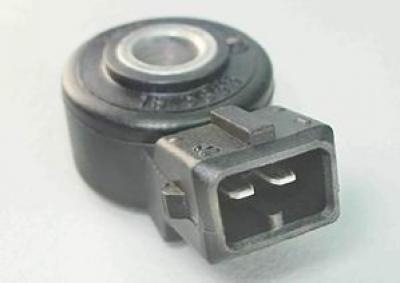
Knock sensor
Mass air flow sensor (DMRV) film type, installed between the air filter and the throttle valve. Based on the signal from the sensor, the ECU calculates the amount of air entering the engine cylinders. In the event of a malfunction of the DMRV, the electronic control unit switches the system to a standby mode of operation.

Mass air flow sensor
Throttle position sensor (TPS) mounted on the throttle body and connected to the throttle shaft. TPS is a variable resistor whose resistance depends on the angle of the throttle valve. Based on the TPS signal, the electronic control unit determines the amount of throttle opening. In the event of a malfunction of the TPS, the electronic control unit switches the system to a backup mode of operation.
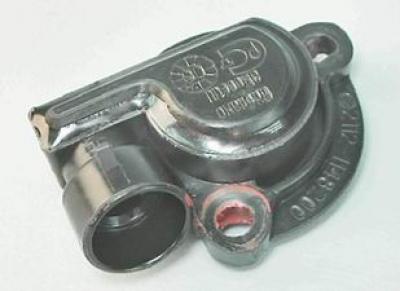
Throttle position sensor
idle speed controller (IAC) is a shut-off valve driven by a stepper motor. The IAC is mounted on the throttle body. The ECU, by supplying a controlled signal to the IAC, regulates the engine speed at idle, when starting and warming up the engine.
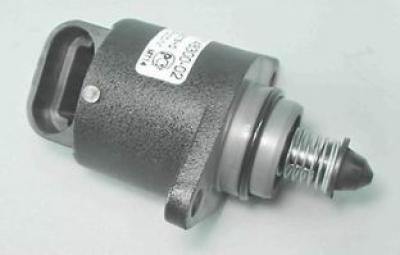
idle speed controller
Oxygen concentration sensor provides an output signal from which the ECU determines the oxygen concentration in the exhaust gases. Based on the data received, the ECU adjusts the amount of fuel injected into the engine cylinders, thereby maintaining the optimal proportion of the air-fuel mixture (this is necessary for the efficient operation of the catalytic converter). The sensitive element of the oxygen concentration sensor is located in the exhaust gas stream (before the catalytic converter). The operability of the sensor is possible only when its sensitive element is heated to a temperature not lower than 300°C. To reduce the warm-up time, a heating element is built into the sensor. The sensor is installed at the bottom of the intake pipe.
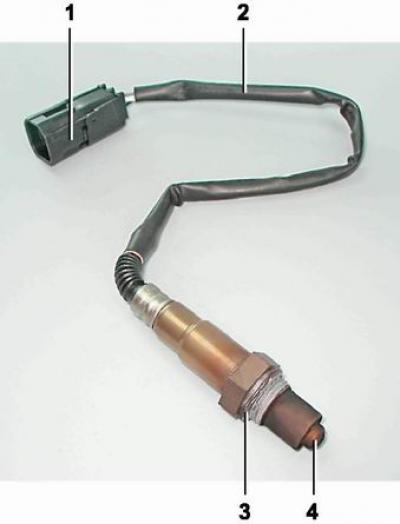
Oxygen concentration sensor: 1 - connecting block; 2 - wiring harness; 3 - sealing ring; 4 - sensing element with holes for supplying exhaust gases
Warning! The presence of lead and silicon compounds in the exhaust gases can lead to failure of the oxygen concentration sensor. Therefore, the use of leaded gasoline is not allowed. When repairing the engine, do not use a sealant with a high content of silicone (silicon compounds), whose vapors can get through the crankcase ventilation system into the cylinders and further into the exhaust tract. Use a sealant that specifically states on the packaging that it is safe for the oxygen sensor.
coolant temperature sensor (DTOZH) - a semiconductor device - a thermistor, the electrical resistance of which changes with a change in ambient temperature. DTOZH is installed in the thermostat housing. Based on the resistance of the sensor, the ECU evaluates the temperature regime of the engine. The obtained data are used in the calculation of most control commands for the elements of the engine control system, as well as for turning on the electric fan of the engine cooling system. In the event of a malfunction of the DTOZH, the electronic control unit switches the system to a backup mode of operation.
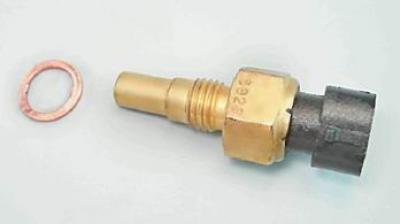
Coolant temperature sensor with copper o-ring
Vehicle speed sensor installed on the gearbox. The principle of operation of the sensor is based on the Hall effect. Based on the pulses generated by the sensor, the ECU calculates the speed of the car. The signal from the sensor is also sent to the speedometer.
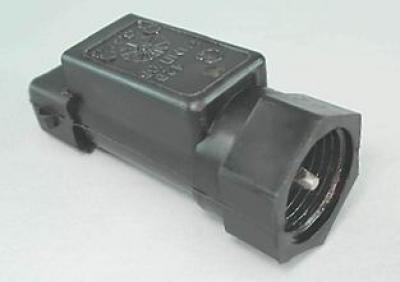
Vehicle speed sensor
An ignition coil is installed on the engine, which consists of two two-pin ignition coils made in a single housing. Sparking occurs in two cylinders at the same time (1-4 and 2-3). The ignition coil is connected to the spark plugs by high-voltage wires with non-removable tips.
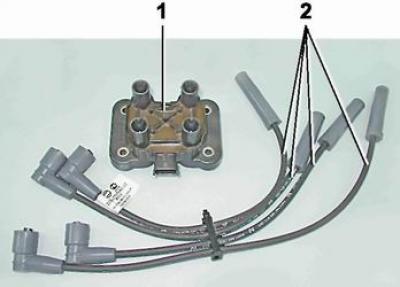
Elements of the engine ignition system 11183 (1,6i): 1 - ignition coil; 2 - set of high voltage wires
Part of engines 2111 (1,5i), on cars of early years of production it was equipped with an ignition module (instead of ignition coil). The module also consists of dual two-output coils installed in a common housing. Additionally, an integrated circuit is located in the housing that controls the operation of the coils.
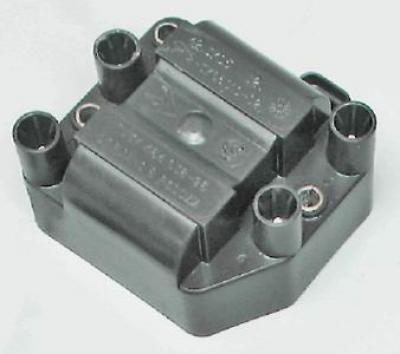
ignition module
On engines, A17DVRM spark plugs are used, where:
- A thread M14x1.25;
- 17 heat number;
- D length of the threaded part 19 mm (with flat seat);
- In the protrusion of the thermal cone of the insulator beyond the end face of the threaded part of the housing;
- Ρ built-in resistor;
- Μ bimetallic central electrode.
Candles from different manufacturers of the same type can be installed on the engine (see "Reference data").
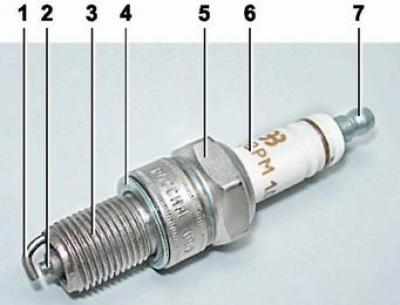
Spark plug: 1 - side electrode; 2 - central electrode (in the thermal cone of the insulator); 3 - threaded part of the body; 4 - sealing ring; 5 - hexagonal part of the turnkey housing; 6 - insulator (It has a spark plug label on it); 7 - contact tip (removable, threaded)
The nozzle is an electromagnetic needle valve, on the outlet pipe of which a sprayer with four calibrated holes is made. The injector opens on a signal from the ECU, while pressurized fuel is injected directly onto the intake valve. The amount of fuel entering the cylinder is controlled by the opening time of the injector. The engine has one injector for each cylinder.
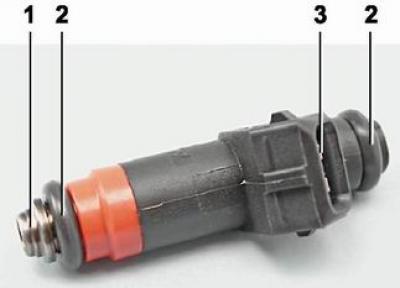
Engine injector 2111 (1,5i): 1 - atomizer; 2 - sealing rubber ring; 3 - terminals for connecting the wiring harness
The canister purge valve is installed on the canister housing cover.
